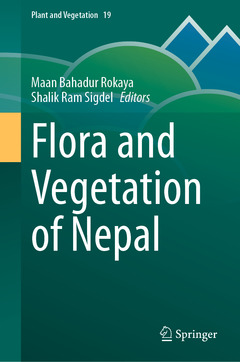Flora and Vegetation of Nepal, 2024 Plant and Vegetation Series, Vol. 19
Coordonnateurs : Rokaya Maan Bahadur, Sigdel Shalik Ram

This volume highlights the plant life of Nepal, which accounts for 20% of the Himalayan biodiversity. For the first time, this group of authors compile over 200 years? worth of local botanical research. Due to the high topographical diversity, Nepal has a very unique flora and vegetation.
The chapters focus on cryptogams, phanerogams and alien flora. As an added bonus, historical background for native and invasive species, is explained. Aside from botanical knowledge, the authors also shed a light on Nepali geography, soil, climate and land use. To complete the picture, readers will find data on different plants, maps and photographs of unique species.
This book is a valuable resource for Botanists and Ecologists, but also for interested travelers who would like to complement their next trek in Nepal.Maan Bahadur Rokaya is currently working as a research scientist at the Institute of Botany and the Global Change Research Institute, both affiliated with the Czech Academy of Sciences. Rokaya obtained his MSc in Botany, specializing in Plant Taxonomy and Systematics, from Tribhuvan University located in Kathmandu, Nepal, in 2001. Subsequently, he pursued his PhD in plant ecology from Charles University in Prague, completing his studies in 2011. The primary focus of his research is mainly on the plant population dynamics of important plant species, herbivory patterns along the elevational gradient, the effects of climate change on plant species, and the spatial distribution of plants, butterflies, and birds, mainly in the Himalayas. He has authored many scientific papers and book chapters.
Shalik Ram Sigdel is working as an Associate Researcher at the Institute of Tibetan Plateau Research, Chinese Academy of Sciences. Sigdel received his MSc in Botany (Ecology) from Tribhuvan University, Kathmandu, Nepal, in 2004 and his PhD in Physical Geography (Treeline Ecology) from the Institute of Tibetan Plateau Research, Chinese Academy of Sciences in 2017. His research focuses on understanding alpine plant responses to changing climate at multiple spatial scales using dendroecological and trait-based approaches, particularly in the Himalayas. He has authored or co-authored about 30 scientific papers.
Date de parution : 04-2024
Ouvrage de 447 p.
15.5x23.5 cm
Thèmes de Flora and Vegetation of Nepal :
Mots-clés :
Cryptogams; Phanerogams; Himalayan region; Invasive Species; Botany; Nepal



